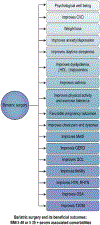Energy imbalance: obesity, associated comorbidities, prevention, management and public health implications
- PMID: 33305001
- PMCID: PMC7725222
Energy imbalance: obesity, associated comorbidities, prevention, management and public health implications
Abstract
The prevalence of obesity has been continually increasing, as have its associated comorbidities and health care costs. Effective management of obesity and early intervention measures are necessary to overcome this global issue. The responsibility for preventing and managing this global epidemic does not lie solely on an individual, but also on the entire health care system. Policy makers-nationally and globally-must play their roles to solve the issue. In this review article, we examine methods of controlling and managing obesity through interventions, such as a low caloric diet, physical exercise, pharmacological guidance, and bariatric surgical procedures. While health care professionals should educate patients about all available treatment options for severe obesity, bariatric surgical procedures have increased in popularity and are considered very beneficial with outcomes fruitful in managing severe obesity.
Keywords: bariatric surgery; comorbidities; diet; management; obesity.
Conflict of interest statement
Conflicts of interest The author declares that there are no conflicts of interest.
Figures







References
-
- Fezeu L, Minkoulou E, Balkau B, et al. Association between socioeconomic status and adiposity in urban Cameroon. IJE. 2006;35(1):105–111. - PubMed
-
- Goris JM, Petersen S, Stamatakis E, et al. Television food advertising and the prevalence of childhood overweight and obesity: a multicountry comparison. 2010;13(7):1003–1012. - PubMed
-
- Swinburn BA, Sacks G, Hall KD, et al. The global obesity pandemic: shaped by global drivers and local environments. LANCET. 2011;378(9793):804–814. - PubMed
-
- Farooqi IS, Keogh JM, Yeo GS, et al. Clinical spectrum of obesity and mutations in the melanocortin 4 receptor gene. N Engl J Med. 2003;348:1085–1095. - PubMed
Grants and funding
LinkOut - more resources
Full Text Sources
